Is it safe for the knees to track past the toes when we perform exercises? In this article, I will try to answer this question uniquely and I will discuss the following topics:
- anatomy and biomechanics
- where did this myth come from?
- why some people are right but have the wrong arguments?
- how is the literature interpreted based on personal bias?
- things that people see and, more importantly, don’t see in the examples that are presented often
- “destructive” forces?
1. Why is this a myth?
You probably heard at least once that “you will destroy your knees if they track over your toes while squatting/lunging”. And this statement has more than one problem.
The first problem is that people who have authority in the fitness field, like coaches or “experienced” people, should not make absolute statements when it comes to movement. Because we do not train movements, we do not train exercises. We train individuals that are anatomically and mechanically unique (as we will see in this article).
And in the opposite corner we have the other people that contradict the statement with “the knees should always track over your toes” or “it doesn’t matter. Although they might have better arguments, compared to the first people I mentioned, they might still be wrong. Because we don’t train movements or exercises. We train individuals who have certain capabilities and certain goals, in certain periods of their fitness journey.
We do not need to choose between option A and option B when we deal with individuals. And another problem is that most of these “experts” don’t even know what a “knee” is.

2. So what is a knee?
The knee is the joint where the bones of the upper leg and the bones of the lower leg meet. The knee consists of the femur, patella, and tibia and has some cartilage pads named meniscus, a joint capsule, and some ligaments (most important: anterior and posterior cruciate ligaments).
I should mention that the knee has more components that are not worth taking into consideration for this specific article.
So, since the knee has so many components, is there a movement or action that can “destroy” your knee? The whole knee? Or are we using vague terms because we don’t know what’s going on at the knees?

3. Pliability
What happens, exactly, when we squat? First of all, we need to keep balance somehow. That means that we have a center of mass. If we change our center of mass too far forward, we will fall forward. If we change our center of mass too far backward, we will fall on our backs.
This also happens in a squat. The center of mass is, usually, right over the middle of the foot. The bar will always stay above the middle of the foot to maintain balance, regardless of how you place the bar (or other free weights) [1].

But the problem is that to maintain that center of mass, more joints need to influence one another, and restricting one will lead to compensation for the others. For example, if you will not allow your knees to move forward, you will see some compensation at the ankles and one at the hips and lumbar spine. We will see why this is extremely important.
4. The study that you will see posted everywhere
Most probably, you have seen the following picture (from the Fry et al. study [2]) if you have ever looked up this particular subject.

In this image, they show the two variations that they compared: the unrestricted squat and the restricted squat, in which the knees were not allowed to track past the toes. This study concluded that by restricting the squat, knee torque was reduced by 22% but the torque at the hips increased by 1073%. In layman’s terms, although the knees were required to work less, the hips had to work a lot more.
And, as you can also see in the image, the pliability differs and the hips are further back from the center of mass. This means that the study has a correct conclusion. Even more, we can also see that the lumbar spine tends to deviate from its neutral range and this could mean a higher injury risk (as we will see soon).
But the problem with this study is that it can easily bring a confirmation bias. And if we want to be correct with ourselves and analyze deeply, although the conclusion seems correct, the authors didn’t write how they collected the data.
Although the study has the correct conclusion, I don’t think that it can be used as it is frequently used, as an absolute truth, just because it is “a study”. A study with some data that we don’t really know where it came from and a 2D image.
5. What are the images not telling us?
Some “experts” will also come with some more elaborated explanations, like:
- “there will be tension at the knees”
- “there will be pressure at the knees”
- or, even more advanced, “the forces that are produced will damage your knees”
In images or videos, we don’t see forces. At least if we aren’t trained to see them. But if we don’t see them, that doesn’t mean that they aren’t there invariably. And if they’re there that doesn’t mean that they will cause damage. It’s actually the other way around. The presence of these forces allows you to move and their absence would lead to the incapability to create movement.
Just because a force is present, that doesn’t mean it will cause damage. But any force can cause damage if it becomes excessive. And I presume that this incomplete understanding of the matter led to the statement that “the forces that are produced will damage the knees”.
What forces are produced at the knee? We can discuss three categories of forces that can be produced at a joint:
- compressive forces
- shear forces
- tensile forces
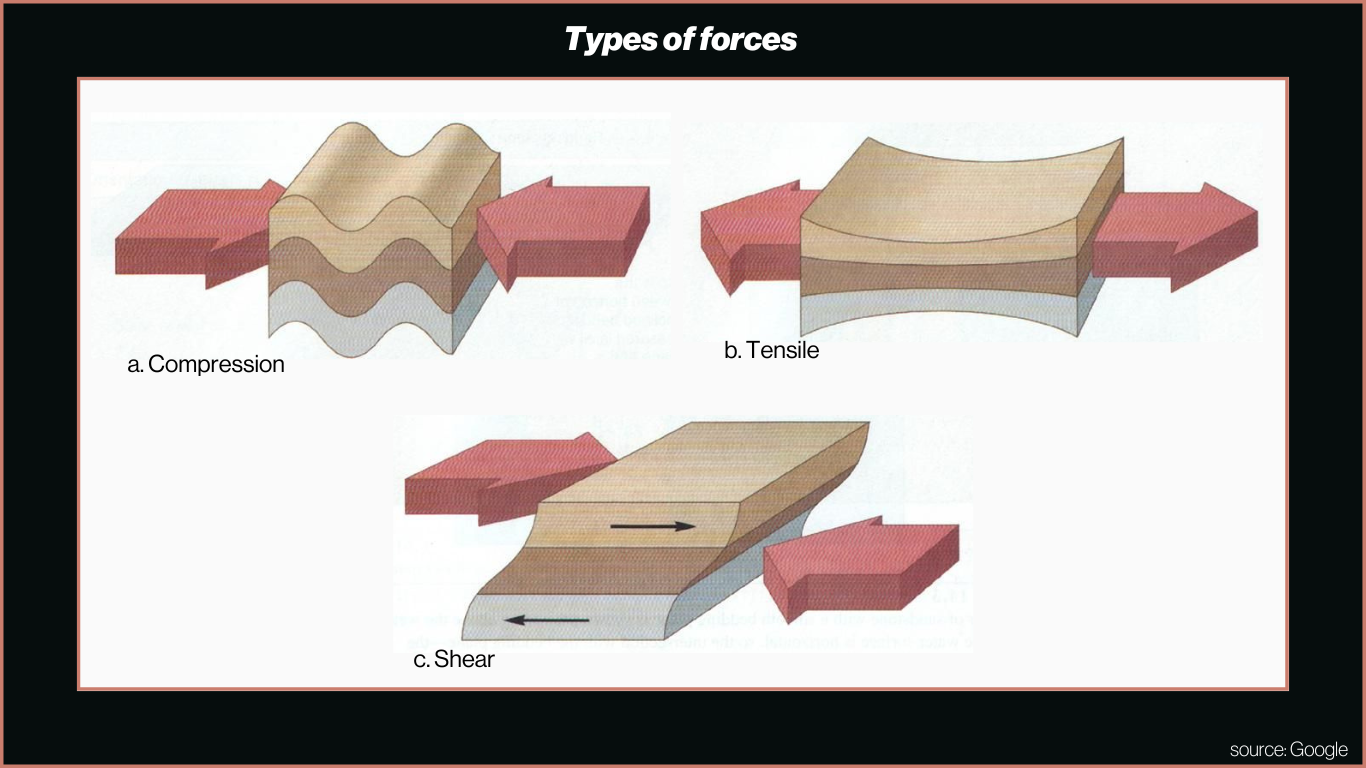
Although we won’t get too deep into the physics part of it, I will try to explain every force and if it can lead to damage when performing certain movements, like squats. From my point of view, the forces that can have the most impact are compressive forces on the patellofemoral joint, being the Resultant (red arrow) of the two forces that are represented in the image. The more we flex the knee, the more the forces will grow and, as a result, the Resultant will grow and it will lead to greater compressive forces.
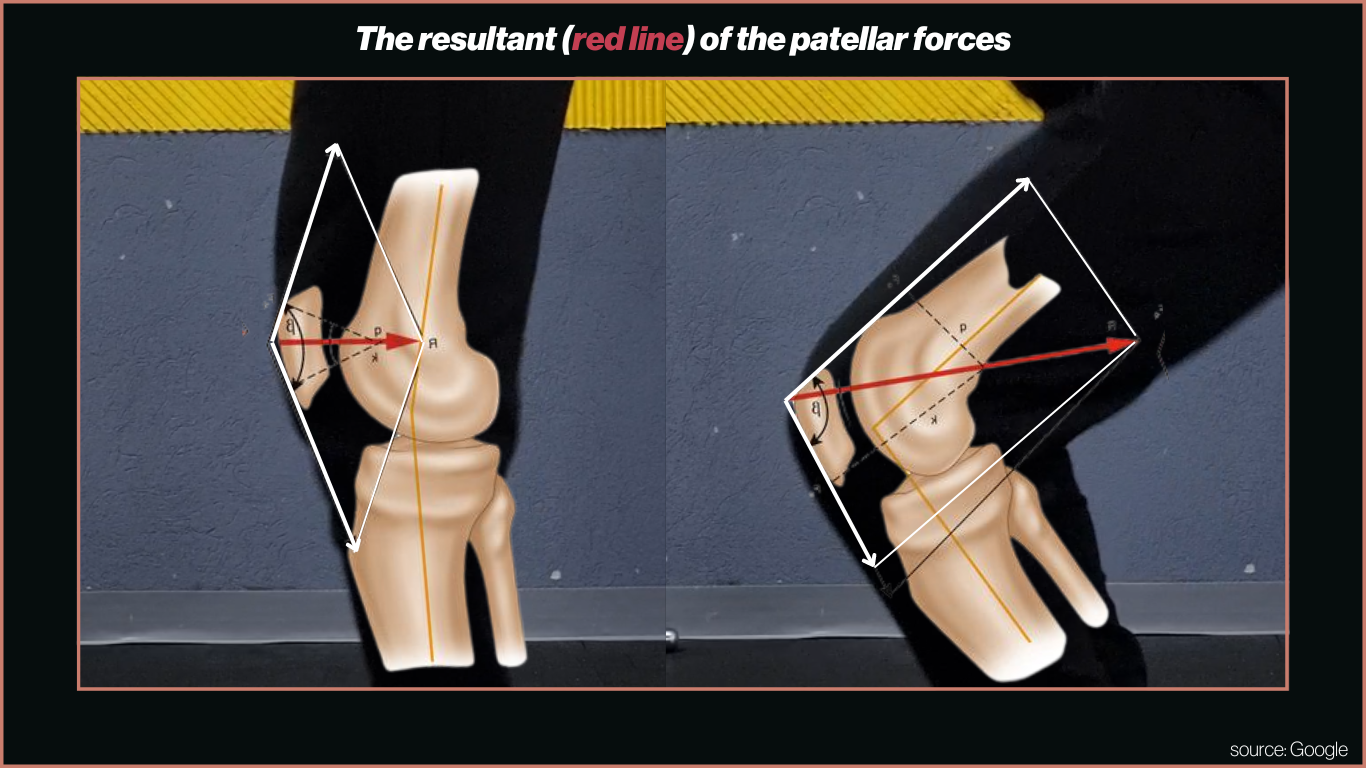
In this study [3], the author concluded that people with healthy knees can well tolerate the compressive forces on the patellofemoral joint and can perform deep squats, with 90-110 degrees of flexion or even greater, because the compressive forces stay constant after about 90-100 degrees of flexion and the stress actually drops because of the increased surface of contact of the patella.
But what about the compression forces on the tibiofemoral joint? Those forces also increase with increasing knee angle. And the greatest tibiofemoral compression forces were recorded in a study where the participants used weights that were 2.5 times greater than their body weight. And they found these forces to also be well tolerated [4]. More so if we remember that most people won’t probably use such big weights.
The maximum anterior shear forces, in a squat, are developed in the first 60 degrees of flexion (when the knees don’t go over the toes). The greatest forces applied to the Anterior Cruciate Ligament (ACL) were recorded to be around 95 N, representing around 6% of the maximal strength of a healthy ACL [5]. A part of these forces is alleviated by the co-contraction of the hamstrings.
Furthermore, in Toutoungi’s study [5], forces on the ACL were greater when the squat was performed with the feet on the ground compared to the squat with the heels elevated, both on the ascent and descent phases of the movement. And we know one thing for sure: when you lift the heels more, the anterior translation of the knees will be greater (ie: the knees go over the tops even more). But the forces are decreasing.
Posterior shear forces start to develop at approximately 30 degrees of flexion and increase with increasing knee flexion but not beyond 90 degrees, from where they begin to decrease as the degree of flexion increases toward 120 degrees. Plus the highest forces on the Posterior Cruciate Ligament (PCL) were about 2222 N, which is about 50% of the estimated total of a healthy person [4].
The tensile forces that develop on the patellar tendon are approximately between 10,000 and 15,000 N, values that are below the maximum limit of this tendon. So, from this perspective as well, it is unlikely that the forces will become excessive for healthy people.
From the point of view of the compressive forces on the menisci and the articular cartilage, there could be an increased risk of injury at high degrees of knee flexion, but unfortunately, there are no guidelines to determine the magnitude of the forces required for these injuries to occur.
The conclusion is that the “forces” that develop at the “knees” are well tolerated, in general, by healthy people. As I said above, any force can become excessive if it is not applied correctly.
6. What else aren’t these images telling us?
Velocity. The speed of the reps.The acceleration and deceleration that those people produce in motion. High acceleration or increased need for deceleration will produce higher forces. This is even indicated in the literature [4] that shear forces can increase by up to 33%, and compressive forces can double, in the case of performing a high-velocity squat.
So is it safe for the knees to get over the toes? It seems to also depend a little bit (more) on velocity.
7. When else don’t we see in images (and most coaches don’t see/don’t know)
People are not symmetrical. People do not have perfect joints. The contact surfaces within some joints change depending on the degree of flexion, but also the relationships between them. Sometimes for better, sometimes for worse. People have different proportions (we will discuss this in another article). Some have a longer foot, some have a shorter tibia, some have a longer femur, and so on.
Connective tissues adapt over time as you follow a training program. This means that initially, it can be harmful to the “knees” to get over the toes, and then, following adaptations, it is no longer harmful. Or vice versa.
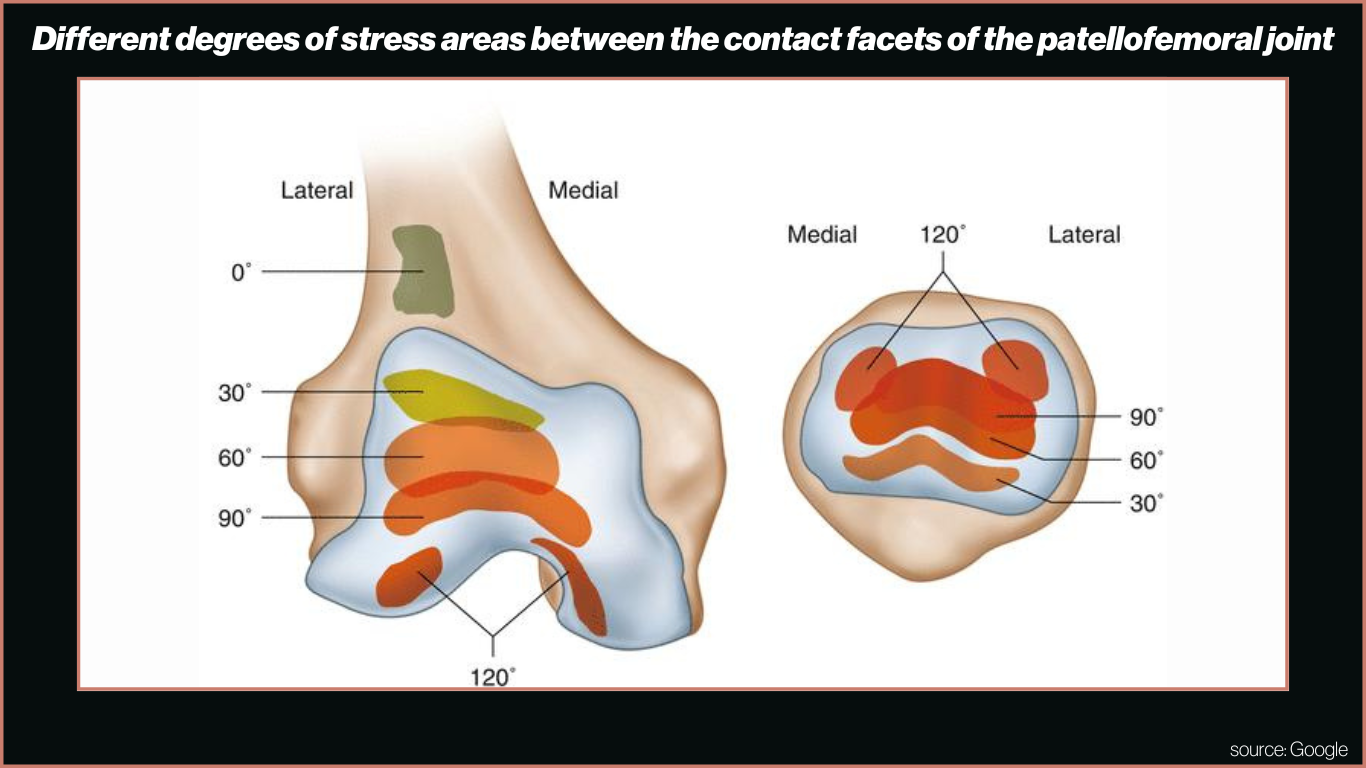
8. What can happen if we restrict the movement?
I was saying above, and as we also saw in the image of Fry et al. study, the restriction of one joint will lead to compensations within the other joints. By restricting the knees we will increase the shear forces at the lumbar spine. They increase when the trunk has a greater forward lean, as in the restricted squat.
Performing squats with the spine out of neutral range will decrease the moment arm for the spinal erectors, will reduce the tolerance to compressive forces, will increase shear forces, and result in a greater transfer of forces from muscles to passive tissues, increasing the risk of disc herniation [4].
This conclusion is in line with the conclusion of the Fry et al study: by decreasing the forces at the knees, we will significantly increase the forces at the hips/lumbar spine. Alternatively, by removing that arbitrary restriction, we will decrease the forces on the spine [7].
What can help us in making a decision? An arbitrary rule to apply to everyone? Like “knees must not go past the toes”? Or “the knees must exceed the toes”? Or are we interested in the risk-to-benefit ratio for that individual, with his/her capabilities, at that specific moment in his/her life?
9. What else can happen if we restrict the movement?
As the force system changes and the degrees of flexion change, so do the forces developed by the muscles involved in that movement. Given people’s different goals, does it help us to use arbitrary rules like “the knees should not go over the toes”?
What if that restriction leads to suboptimal development of the quads, which could be the primary goal of a person with healthy knees, who has a very low injury risk? [8][9]
10. Is it really wrong for the knees to go over the toes?
Let’s see what happens when you walk. Let’s see what happens when you climb the stairs. When you go down the stairs. When you run. All these activities must produce an anterior translation of the knees over the toes.
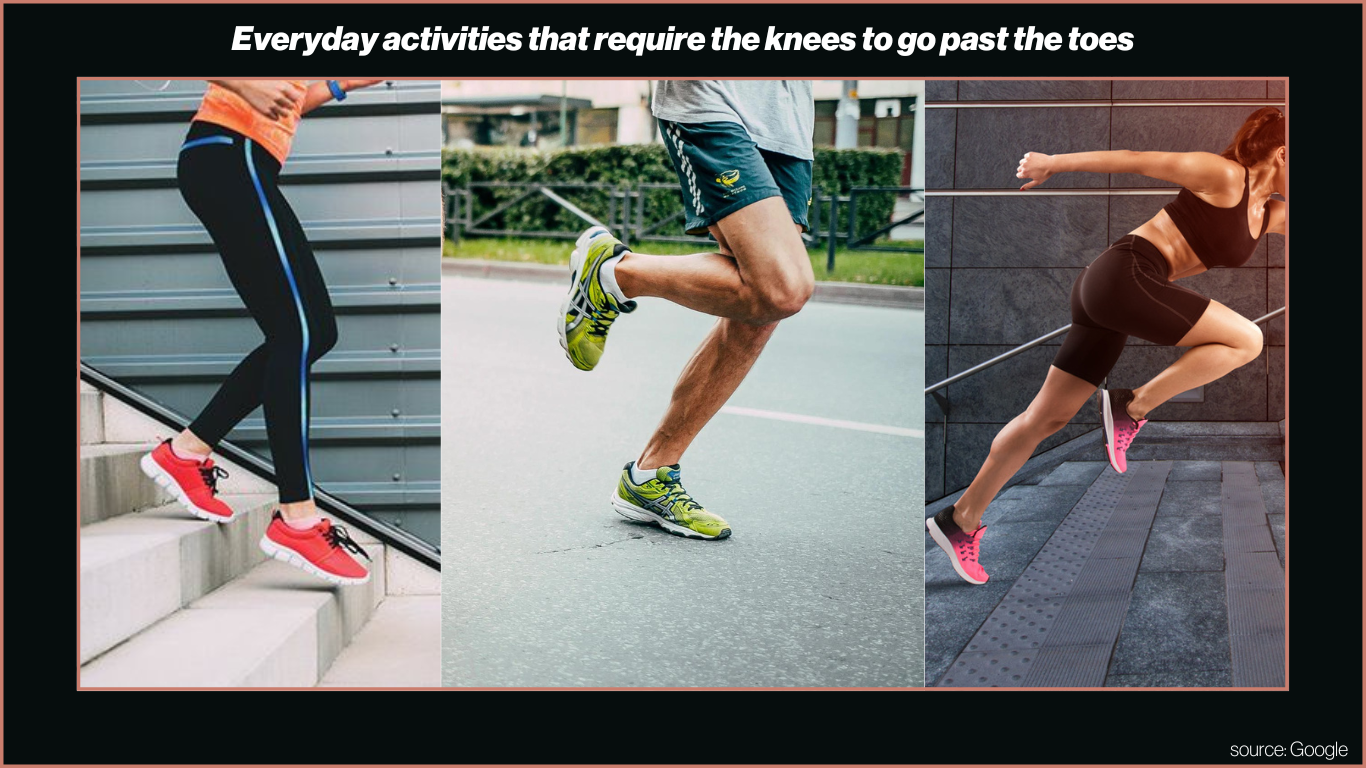
11. Are “knee” forces actually reduced?
Let’s take the example of wall sit vs. unrestricted squat. Considering that in this exercise the knees do not go over the toes, it means that the “forces” that occur at the “knees” are smaller and the exercise is safer. Correct? Might be wrong and the forces may be higher.
Look what happens in a wall sit and why your quads work hard: for you to stay in that position, a frictional force is needed between your feet and the ground. Two forces result from this: the one that doesn’t let your feet slide forward, and the one that comes from the ground and pushes against the feet from the bottom up. When we draw the resultant of these forces (again in red), we notice that this will create a moment arm (drawn in blue) that is greater than the moment arm for the restrained squat.
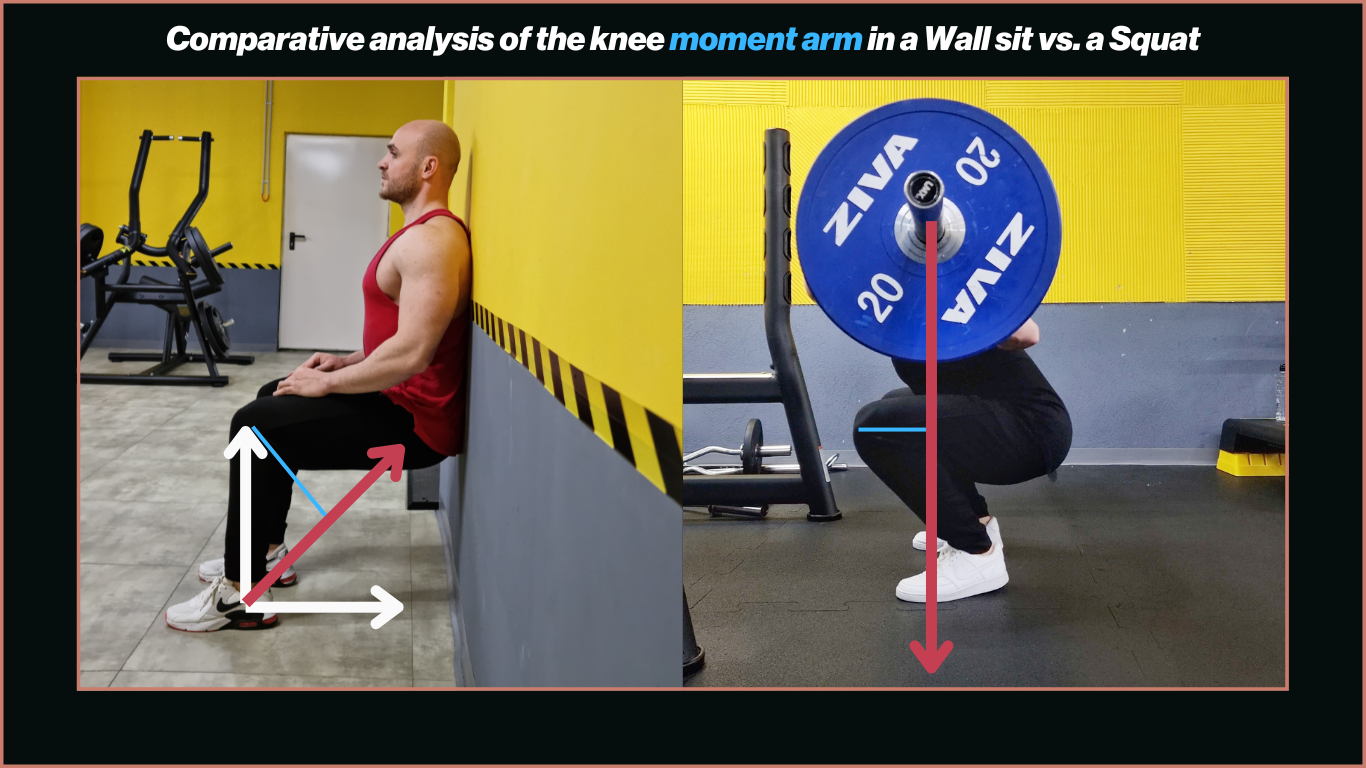
In layman’s terms, the forces that develop at the “knees” will be greater for the wall sit compared to the unrestricted squat (considering that we are not applying a high velocity).
12. Conclusion
While people’s demand lately is for quick and easy-to-digest content, information that will truly help you in the fitness field still needs to be based on context.
Given that the forces developed are easily tolerated and anterior translation of the knees over the toes is a natural movement, this will be safe for most people with healthy knees in most cases and for most purposes. For these people, it is recommended that the knees go over the toes while squatting and lunging, as long as the movements are adapted to their goals.
But we do not need to choose sides and use absolute terms. Because there are also people who will not benefit from this recommendation, such as those who experience knee pain or who have had previous injuries. Fitness is about individualization, not absolutes.



